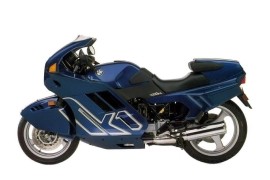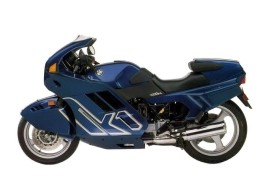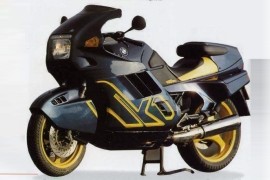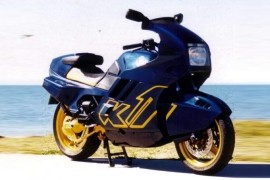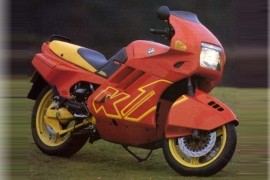BMW K 1 Models/Series Timeline, Specifications & Photos
First production year: 1987
In 1991, the German motorcycle manufacturer launched the BMW K1, a fully dressed sports touring machine, in the fourth consecutive production year. The bike debuted in 1988 as a replacement model for the BMW K100 and continued production until 1994.
When first released in 1988, the motorcycle created a controversial discussion in motorcyclist circles about the sophisticated aerodynamic body concept down to the last detail, starting from the almost wholly covered front wheel to the rear end with a passenger seat cover.
The 1991 model came in the same shape and form as previous ones, packing the same technical, performance, and visual specifications without any significant changes whatsoever.
The bike's appearance was characterized by standard fittings, like a full fairing with a large rectangular headlight, a small windscreen, a sizeable front fender that covered almost half of the wheel, a side stand, and three-spoke alloy wheels.
As for the power figures, the 1991 BMW K1 had installed a 987cc four-stroke liquid-cooled four-cylinder engine underneath its armor. The engine was managed by a fuel injection system and delivered an output power of 100 hp at 8,000 rpm and 100 Nm (74 lb-ft) torque at 6,750 rpm.
All the power was sucked into a five-speed transmission with a dry single-plate clutch and sent to the rear axle via a final shaft drive, launching the motorcycle to 240 kph (149 mph).
The BMW K1 was a fully-faired sport touring motorcycle produced by BMW from 1988 to replace the BMW K100 and manufactured until 1993. From 1988 to 1993, the maker manufactured over 6,900 units.
In 1999, the German motorcycle maker released the BMW K1, a sports touring machine, in its third consecutive production year. The bike was designed for those riders who make zero compromise when it comes to performance but in a reliable and comfortable package.
The 1990 BMW K1 came with the same package as previous models, offering the same technical, performance, and visual specifications without any significant modifications whatsoever.
The motorcycle was manufactured around a steel frame that housed the suspension system, which comprised a hydraulic telescopic fork on the front and a single-sided swingarm tied to a single shock absorber, offering optimum suspension performance and handling.
The braking power was achieved by a Brembo system comprising two 305 mm brake discs with four-piston calipers on the front wheel and a 285 mm brake disc tied to a single-piston caliper on the rear wheel.
As for the power figures, the 1990 BMW K1 had its heartbeat set by a 987cc liquid-cooled four-stroke four-cylinder engine with a fuel injection system providing gas to the pistons, delivering an output power of 100 hp at 8,000 rpm and 100 Nm (74 lb-ft) torque at 6,750 rpm.
In 1989, the German motorcycle manufacturer launched the BMW K1, a fully-faired sport touring motorcycle in its second production year. The bike debuted in 1988 to replace the BMW K100 and was manufactured until 1993 in over 6,900 units.
The 1989 motorcycle came in the same shape and form as the previous one, delivering the exact visual, technical, and performance specifications without any significant modifications except for color alterations.
It also packed the same standard fittings, like a full fairing with a large square headlight, a small windscreen, a sizeable front fender that covered almost half of the wheel, a side stand, and three-spoke alloy wheels.
The 1989 BMW K1 was powered by a 987cc four-stroke, four-cylinder liquid-cooled engine managed by an Electronic Fuel Injection (EFI) system, boasting 100 hp with a peak force at 8,000 rpm and 100 Nm (74 lb-ft) torque at 6,750 rpm.
The bike's engine was married to a five-speed manual gearbox that delivered the power to the rear end via a final shaft drive, pushing the motorcycle to a top speed of 240 kph (149 mph).
From top speed to a complete halt, the motorcycle relied on two 305 mm braked discs with four-piston calipers mounted on the front wheel and a 285 mm brake disc with a single-piston caliper mounted on the rear wheel.
The BMW K1 was a sport touring motorcycle manufactured by BMW from 1988 to replace the BMW K100 and produced until 1993. From 1988 to 1993, the maker manufactured over 6,900 units.
When released, the bike created a controversial discussion in motorcyclist circles about the sophisticated aerodynamic body concept down to the last detail, which started from the almost wholly covered front wheel to the rear end with a passenger seat cover.
In the visual department, the bulky machine was characterized by standard fittings, such as a full fairing with a large rectangular headlight, a small windscreen, a sizeable front fender that covered almost half of the wheel, a side stand, and three-spoke alloy wheels.
The bike was built around a steel frame that housed a suspension system comprised of a telescopic fork on the front and a Paralever system on the rear, providing optimum suspension performance and handling.
As for the braking power, the bike's wheels were fitted with two 305 mm brake discs on the front and a 285 mm brake disc on the rear. The front discs were squeezed by four-piston calipers, while the rear one was engaged by a single-piston caliper.
In the performance department, the 1988 BMW K1 had hidden a 987cc four-stroke liquid-cooled four-cylinder engine underneath its fairing, boasting 100 hp at 8,000 rpm and 100 Nm (74 lb-ft) torque at 6,750 rpm.
In 1988, at the IFMA Show, BMW launched the K1 motorcycle, which caused a controversial discussion in motorcyclist circles about the sophisticated aerodynamically body concept down to the last detail, which started from the almost completely covered front wheel to the rear end with a passenger seat cover.
The reinforced frame that came from the K 100 model featured a stiffer Marzocchi fork on the front wheel, a Paralever swingarm on the rear wheel, and a four-piston Brembo brake system with 305 mm floating discs, all that to ensure a stable and safe straight-line at high speeds.
To ensure the required 100 hp output, BMW developed the first four-valve cylinder head in the history of BMW Motorrad for the four-cylinder engine. For the first time in the construction of a series motorcycle, the 1988 BMW K1 combined digital ignition and injection electronics.
Combined with the 987cc in-line four-cylinder engine resulted in a power output of 100 hp with a peak at 8,000 rpm and 100 Nm (74 lb-ft) of torque available at 6,750 rpm that launched the motorcycle to a top speed of 240 kph (150 mph).
The model featured standard equipment such as cast-aluminum wheels, a full fairing, a dual seat, passenger grab rails, a side stand, and a front fender that encloses almost half of the wheel, decreasing wind drag.
